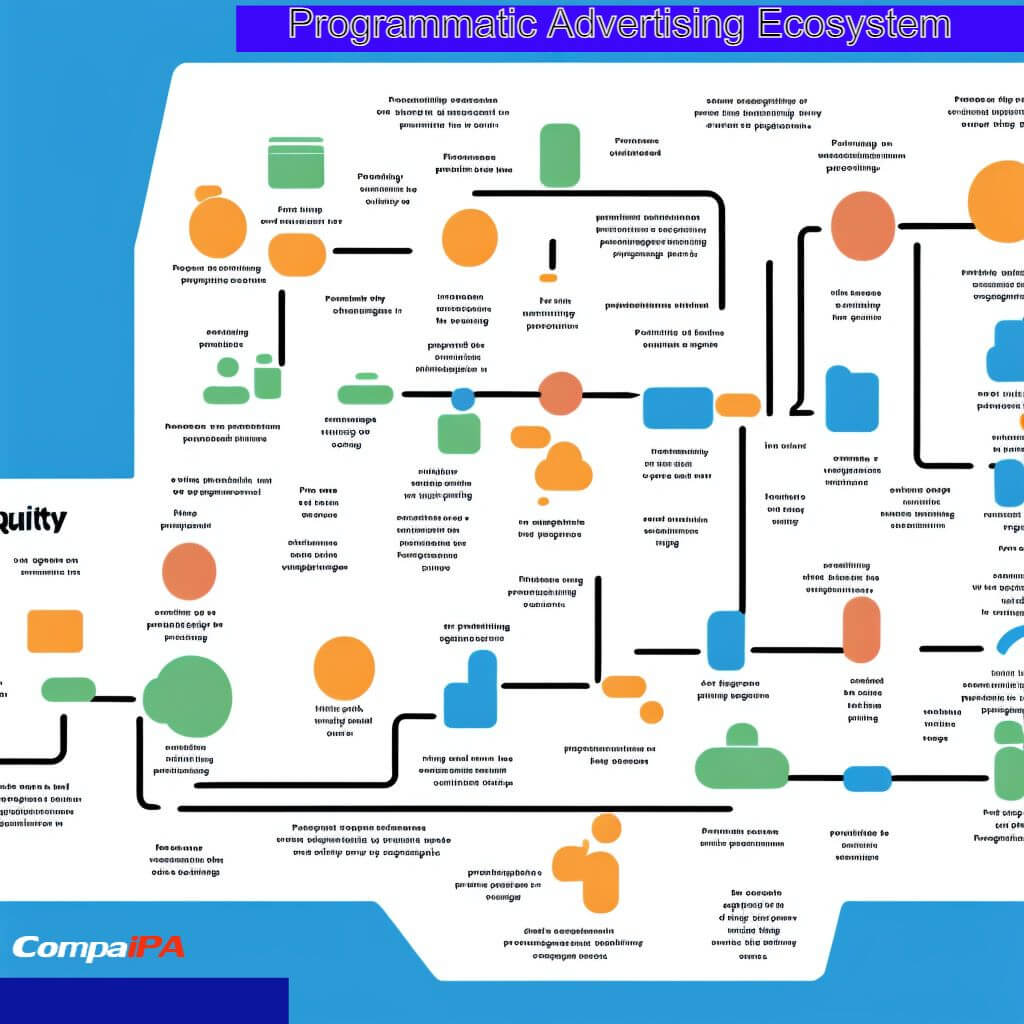
Programmatic Advertising Ecosystem
Get a comprehensive overview of the programmatic advertising ecosystem, its benefits and challenges. Learn about the different components of this complex system especially the latest statistics and insights into the Programmatic Advertising Ecosystem and how it can be used to increase performance and reach customers more effectively.
Table of Contents
What's a Programmatic Advertising Ecosystem?
The Different Components of the Programmatic Ecosystem
Benefits of the Programmatic Advertising Ecosystem
Trends in the Programmatic Advertising Ecosystem
Best Practices in the Programmatic Advertising Ecosystem
Conclusion
What’s a Programmatic Advertising Ecosystem?
Programmatic advertising is an automated, technology-driven process for buying, selling, and placing digital advertising. It is transforming the way digital ads are bought, sold, and placed by streamlining the ad-buying process so that marketers, publishers, and advertisers can quickly and accurately buy and sell digital inventory in an efficient and cost-effective manner. The programmatic advertising ecosystem has grown substantially over the last few years, with more participants entering the market and more established players expanding their presence. This has created a vastly complex ecosystem of buyers, sellers, ad tech companies, and other stakeholders, each of whom plays an integral role in making programmatic advertising work.

''I think programmatic buying in all its forms is necessary for the future of online advertising. It will underpin growth in all message formats.''
Jeff Green
At its core, the programmatic advertising ecosystem is made up of two primary players: buyers and sellers. Buyers are typically advertisers, marketers, or agencies that are looking to purchase digital inventory (ads) in order to target specific audiences. Sellers are typically publishers and websites that offer digital ad space to buyers. In order to facilitate this transaction, numerous other players are also involved.
Components of the Programmatic Advertising Ecosystem
There are several components of the programmatic advertising ecosystem. Ad tech companies are software companies that offer various services and technologies to enable buyers and sellers to connect and transact. These services can range from data management platforms and demand-side platforms to ad exchanges and supply-side platforms. Data management platforms, for example, help buyers collect, analyze, and store user data for targeting and frequency capping, while demand-side platforms enable buyers to bid and purchase inventory from ad exchanges.
The complexity of the programmatic advertising ecosystem is further enhanced by a host of other digital players, including ad networks, analytics providers, ad exchanges, and ad verification companies. Ad networks, for example, offer media buying services to buyers, allowing them to purchase inventory from advertisers, media sellers, and digital publishers in a centralized marketplace. Analytics providers often provide data and insights to buyers and sellers to help inform the optimization of media buying and selling strategies. Ad verification companies provide buyers and sellers with the assurance that the ad placements they buy and sell are actually being seen by the intended audience.
The programmatic advertising ecosystem is an ever-evolving landscape, with new players and technologies continually entering the market. While this has created many opportunities for buyers, sellers, and other stakeholders, it has also resulted in a much more complex and sometimes difficult-to-navigate marketplace.
It’s important for all stakeholders to understand the role that each player plays in order to effectively buy, sell, and place digital ad inventory in the most efficient and cost-effective manner.
In addition, vendors are also an essential part of the programmatic ecosystem. They provide a range of services, such as providing analytics solutions, fraud detection solutions, and data-enrichment solutions to ensure the efficiency and accuracy of programmatic transactions.
Benefits of the Programmatic Advertising Ecosystem
The programmatic ad ecosystem is complex, and it is important for all stakeholders to understand the role that each player plays in order to effectively buy, sell, and place digital ad inventory in the most efficient and cost-effective manner. By understanding the programmatic advertising ecosystem, advertisers can take advantage of the immense benefits that programmatic buying offers. With the ability to target specific audiences, optimize campaigns in real time, and purchase digital advertising inventory from a variety of sources, programmatic buying has become an integral part of the digital advertising landscape. programmatic advertising, the advertising ecosystem
Trends in the Programmatic Advertising Ecosystem
Programmatic advertising is an emerging trend in the marketing space, enabling both buyers and sellers to automate manual advertising processes in real-time and with greater efficiency. Its flexibility and scalability make it an attractive option for both small and large enterprises, making it one of the most popular online advertising strategies today. As such, it is essential to stay up to date on the latest trends and best practices of the programmatic advertising ecosystem. One of the core trends in the programmatic advertising ecosystem is the rise of private marketplace deals. These deals are negotiated between the buyer and the seller, and they often offer higher CPMs, better targeting, and improved data privacy. Private marketplaces also help create better relationships between buyers and sellers, as the two parties are negotiating in an intimate and controlled environment. Another core trend is the increased use of data for better targeting and higher conversions. With programmatic advertising, buyers are able to leverage their data collected over time in order to target the right audiences. By leveraging data, buyers can significantly increase the effectiveness of their campaigns. Additionally, buyers can also use data to measure the performance of their campaigns, allowing them to make more informed decisions and further optimize their campaigns. Finally, the trend of independent programmatic platforms is another important part of the ecosystem. These platforms are third-party systems that allow buyers and sellers to interact without the need for a direct relationship. By using these platforms, buyers and sellers can access more buyers, gain greater control over their campaigns, and reduce the costs associated with programmatic advertising. Another trend is the shift toward mobile advertising. As device usage continues to grow and consumers become more comfortable using their phones, more advertisers are shifting their programmatic buying to mobile platforms. As mobile platforms have different requirements and possibilities than desktop platforms, it is important for advertisers to ensure they are familiarizing themselves with the nuances of the mobile advertising ecosystem.
Best Practices in the Programmatic Advertising Ecosystem
Recent research suggests that programmatic ad spending is increasing at an accelerated rate each year. This is largely due to the increasing popularity of real-time bidding (RTB), and automated buying and selling of online advertising inventory. With the growth of RTB, marketers need to be knowledgeable on the most up-to-date practices to stay competitive. One of the most important best practices is to keep a close eye on recent advancements in the programmatic ecosystem. New technology, such as artificial intelligence (AI) and machine learning (ML), has allowed the process to become faster, more efficient, and more accurate. AI can make more accurate predictions on the success of an ad, while ML can detect fraud and create better targeting methods. In addition, marketers should also become familiar with the various types of programmatic ad platforms. Platforms such as Google Ads and Facebook Ads are two of the most popular options for programmatic advertising. Knowing which to use and how to use them correctly is key to successful campaigns.



Conclusion
In conclusion, advertisers should also ensure they are taking advantage of the transparency and accountability offered by programmatic advertising. This is a system that was designed for transparency, with advertisers being able to view the entire supply chain, from the source of the inventory to the actual ad impression. This has provided them with greater insight into the effectiveness of their campaigns and allows them to adjust their strategies accordingly.
By following these trends and best practices, advertisers are ensuring they are taking full advantage of the opportunities available within the programmatic advertising ecosystem. Keeping ahead of the curve is essential in the fast-paced nature of programmatic advertising and understanding the latest developments will help advertisers get the most out of their campaigns. Advertisers should focus on automation, mobile advertising, and transparency to ensure they are making the most of the programmatic advertising ecosystem and achieving the best performance.
Are you ready to revolutionize your marketing strategy? Join the Programmatic Advertising Ecosystem for access to creative solutions, research insights, and powerful tools. Sign up with CompaiPA today and unlock advanced strategies for your campaigns.
Published December 8, 2022, by Adebola Adeola CEO Dinet Comms Owners of CompaiPA Group.








